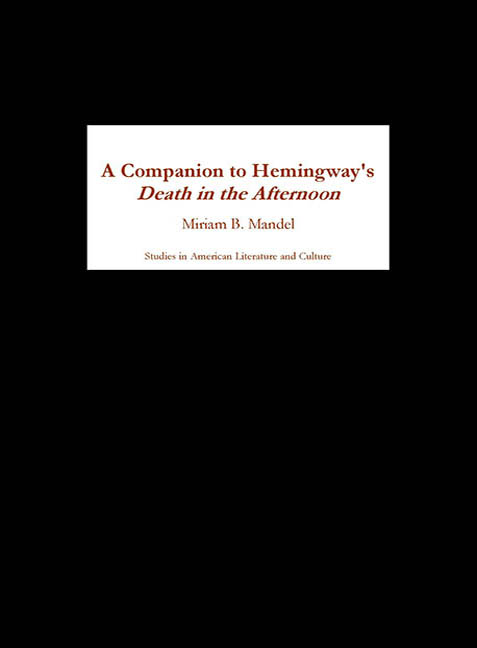Book contents
- Frontmatter
- Dedication
- Contents
- Acknowledgments
- Hemingway Works That Address the Bullfight
- A Note on the Text of Death in the Afternoon
- Introduction
- Composition, Sources, and Backgrounds
- Reading Texts, Paratexts, and Absence
- “The Real Thing–? Representing the Bullfight and Spain in Death in the Afternoon
- “Very Sad but Very Fine”: Death in the Afternoon 's Imagist Interpretation of the Bullfight-Text
- “Far from Simple”: The Published Photographs in Death in the Afternoon
- Deleted “Flashes”: The Unpublished Photographs of Death in the Afternoon
- “¿Qué tal, hombre, qué tal?”: How Paratexts Narrow the Gap between Reader and Text in Death in the Afternoon
- On Authorship and Art
- And What Came After
- Works Cited
- Notes on the Contributors
- Index
Deleted “Flashes”: The Unpublished Photographs of Death in the Afternoon
from Reading Texts, Paratexts, and Absence
Published online by Cambridge University Press: 27 April 2017
- Frontmatter
- Dedication
- Contents
- Acknowledgments
- Hemingway Works That Address the Bullfight
- A Note on the Text of Death in the Afternoon
- Introduction
- Composition, Sources, and Backgrounds
- Reading Texts, Paratexts, and Absence
- “The Real Thing–? Representing the Bullfight and Spain in Death in the Afternoon
- “Very Sad but Very Fine”: Death in the Afternoon 's Imagist Interpretation of the Bullfight-Text
- “Far from Simple”: The Published Photographs in Death in the Afternoon
- Deleted “Flashes”: The Unpublished Photographs of Death in the Afternoon
- “¿Qué tal, hombre, qué tal?”: How Paratexts Narrow the Gap between Reader and Text in Death in the Afternoon
- On Authorship and Art
- And What Came After
- Works Cited
- Notes on the Contributors
- Index
Summary
In his unpublished introduction to the photo-essay of Death in the Afternoon, Hemingway bemoans the fact that financial considerations made it impossible to publish all of the “four hundred photographs, drawings and paintings [that] were obtained or made to show the phases, technical and otherwise of the modern Spanish bull fight” (“Some four hundred photographs,” Hemingway Collection, John F. Kennedy Library [Boston], Item 48). That large collection features about sixty matadors, most of whom I have been able to identify. When he was forced to lower his sights, Hemingway prepared a lightly annotated, five-page list or outline of the images he wanted: it specifies some one hundred and twenty items and names about forty-five different matadors. In a note at the top of this outline, Hemingway mourns that so “many must go — cannot be comprehensive — must be flashes — god damned shame” (“Necessary photographs,” JFK, Item 30). And indeed, many went: when the book was finally published, it showed only eighty-one illustrations, foregrounding twenty-six matadors (some of whom also appear in the background of other photos). The winnowing was drastic — from “some four hundred” to one hundred and twenty to eighty-one photos, and from sixty to forty-five to twenty-six matadors. Clearly, Hemingway had many decisions to make.
Hemingway had a discerning eye, and most of the items he collected are really fine. A few are blurry, although Hemingway may have prized them for historical considerations. And it is interesting that the collection, large as it is (some three hundred and thirty items survive in the JFK), seems to be incomplete. Some of the images mentioned in Hemingway's list are missing. Hemingway indicates, for example, that he would like to include photos of “Armillitas I and II very Indian [Armillita]1 great banderillero — [Armillita] 2nd child wonder — cold, disillusioned” (Item 30). The John F. Kennedy Library holds several photographs of Fermín Espinosa, known as “Armillita chico” or “Armillita II,” but none that I could identify as being of his older brother, Juan Espinosa (Armillita, that is, the older or first of the Armillita brothers). Hemingway also listed “Waldo Peirce — pile up in the encierro at Pamplona” (Item 30), but the JFK does not hold that painting or drawing.
- Type
- Chapter
- Information
- A Companion to Hemingway's Death in the Afternoon , pp. 189 - 204Publisher: Boydell & BrewerPrint publication year: 2004

